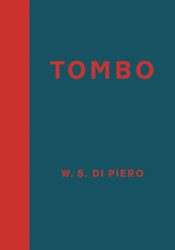
Inundation—. Both aural and lived. When I read W.S. Di Piero’s poems—and particularly those in his new book Tombo—I wonder if the world doesn’t dizzy him unremittingly, given how permeable he seems to be to that very world. Di Piero is that pleasing and startling combination of poet: both a vast thinker and utterly sensate. Attuned, like the dog in the preamble poem to the volume, “The Running Dog”:
…and the body
quivers through its days
unawares, but sensate,
like a dreaming dog
in the still, marbled air
of its own running, the felt
and numb times in between…
Most readers, I suspect, curious about the book’s title, will flip to the last poem from which the volume takes its name. There are some clues here, but one has also to bring that poem into relationship with the line drawing by Paul Klee on the book’s frontispiece and with the preamble poem just mentioned.
The drawing by Klee, “Delapidation of an Architecture,” presents to the reader first-thing the façade of a Victorian-row-home-like building. But the architecture is broken down into separate, component elements, no two touching—mostly recognizable architectural forms, with one chaotic, jumbled spot of shapes at the bottom. The overall impression is one of fragility and disconnect, which joins “The Running Dog’s”
“…things around us,
this pigeon feather, acorn,
rinds and grounds and crusts,
any this or that, or words
that pass between us,
while we keep trying to say
here by the stove or on your street
exactly what it’s like.”
This then joins the presiding yearning in the poem “Tombo,” a search to piece together “one / inarticulate incoherent moment to the next,” a craving for “plain rotund stories/ to justify our continuity.”
Not to belabor this set of rewarding initial steps—but they do set up well the deep, seeking quality of the book. An exploration of what we as “faint believers” try to believe in.
At times, Di Piero reads very much like a true descendant of the Romantics. Some poems reminding me of the fullness of experience Wordsworth achieves, but a Wordsworth version 2.0, brought into the present day and given some instruction in succinctness and more modern and labile, associative leaps. Or shades of Keats with the soft spot being so often pierced by experience. These poems, however, are not recollections undertaken in tranquility: Di Piero’s “vagrant imagination rushes toward the world” and the tsunami of that world rushes in—that “…indifferent world/ that rivers through and past me.”
 At a time when so much of the poetry we read is wan, with nothing that sticks, I have always relished the musicality of Di Piero’s work, his songs with memorable phrases and vivid moments. Many have come to expect this rich experience of sound in his poems. And we find it everywhere in Tombo. Di Piero—again in the searching tone of this book—“craves/ a sound that blends the dirt and air” and a music “giving incoherence a restless shape.” These lines from the poem “Hub Cap: An Essay on Poetry,” could also surely hearken back to the visual correlative, the Klee drawing at the very start of the book. Here is a passage that one could only call a pyrotechnics of sound, from the poem “The Black Paintings: The Mouth”:
At a time when so much of the poetry we read is wan, with nothing that sticks, I have always relished the musicality of Di Piero’s work, his songs with memorable phrases and vivid moments. Many have come to expect this rich experience of sound in his poems. And we find it everywhere in Tombo. Di Piero—again in the searching tone of this book—“craves/ a sound that blends the dirt and air” and a music “giving incoherence a restless shape.” These lines from the poem “Hub Cap: An Essay on Poetry,” could also surely hearken back to the visual correlative, the Klee drawing at the very start of the book. Here is a passage that one could only call a pyrotechnics of sound, from the poem “The Black Paintings: The Mouth”:
“…Goya’s mouths are sites
of being, fouled canals,
rain rushing gutters to flush
slops and excrement aglitter
with nervous lusts
angers, hungers, grubs
foraging life’s ruins and offal
essential to damnation and glee.”
Interestingly, Di Piero often mentions the word “scenes” in the poems in the book. The way Di Piero attends to the many figures in his “scenes”—a woman being reminded to walk her dog, a the tot with a balloon, a guy with a mullet, a grocery-store prophet like Tombo—recalls to me Whitman’s “The Sleepers” and that ample, allowing to each person, each scene, a kind of grandeur—giving each person his or her full due.
Gradually, as the book continues, we become aware that what Di Piero intuits is of a rare order that we are, at best, very slow to grasp. So deeply does a place flow through him, for example, that we realize we may have been wrong about place all along: “…here you are the nothing/ that is this place, / and all the places are you….” In these scenes, “steady rain isn’t really steady” and Di Piero can testify to the fact that “the quiet of night is not really quiet.” “Our absent autumn,” claims De Piero, “waits for us somewhere.” “And we live this moment / in every other universe” while countless yonders take place right here. This is life’s very “flash and flesh.”
It is, to my mind at least, the poet’s work not only to withstand the “bite and thrust” of the world, but to be its intimate. To me Tombo is a book of great courage and wakefulness, a rally to wakefulness. “If I go numb to our surround, my love,” writes Di Piero, “press your nails into my palm, I’ll do the same / for you, we’ll wake each other, again ….”




